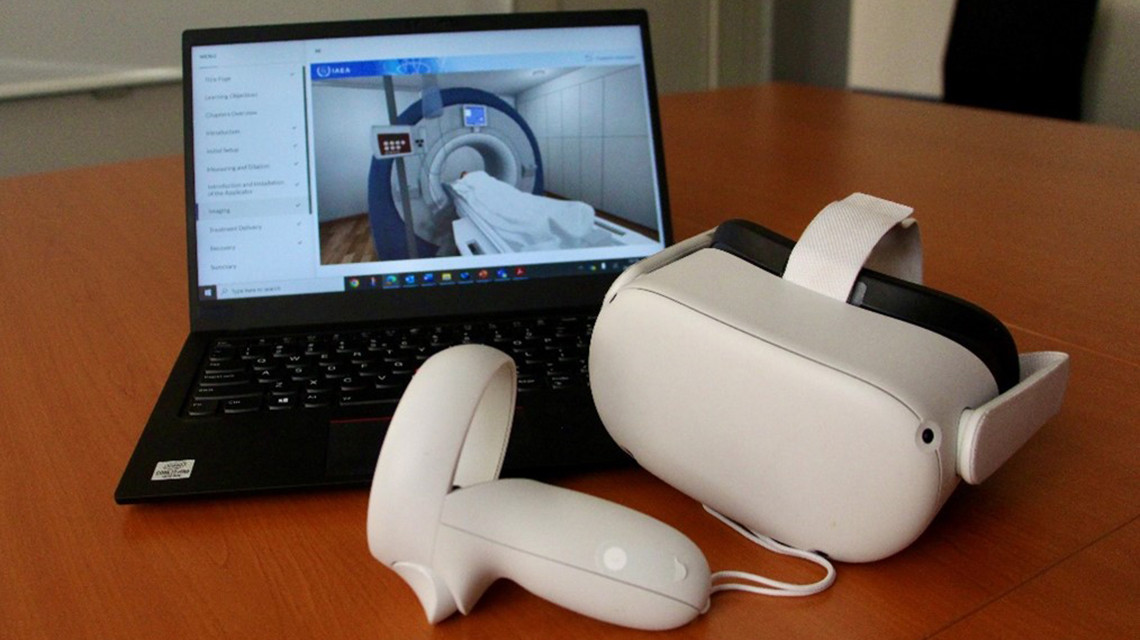To accelerate the speed and scale of progress in the global fight against cancer, the IAEA has developed virtual reality (VR) models of three cancer treatment procedures - leveraging this cutting-edge technology as an innovative training tool for medical professionals across the globe. First debuted in July 2023 during a national training course in Mozambique, the IAEA's models have already catalysed the training of nearly 180 such professions within Africa. For resource-challenged contexts around the world, these state-of-the-art learning tools can help address education and training needs; reduce global knowledge gaps; and, in turn, enable equitable, high-quality care for all.
VR has been gaining in popularity as a training tool since it allows for realistic simulations in highly technical fields, including healthcare. Within cancer care training - which often requires expensive facilities, specialized equipment and rigorous compliance with local laws and regulations during patient interactions - VR can serve as a cost-effective alternative. This is especially true for many low- and middle-income countries (LMICs), where the global gap in education and training continues to widen.
To help bridge this gap, the IAEA developed VR models of external beam radiotherapy, two-dimensional (2-D) brachytherapy and three-dimensional (3-D) brachytherapy - in part with extrabudgetary funding from the United States. In providing trainees with an immersive learning environment, these models enable oncologists, radiation therapists and medical physicists to develop an in-depth understanding of radiotherapy cancer set-ups - from equipment placement to patient positioning. This approach is especially advantageous when the necessary medical equipment is either unavailable in cancer centres or has not yet been commissioned for clinical use.

Virtual reality goggles and the IAEA's recently developed e-learning module "Patient Setup and Positioning for Cervical Cancer External Beam Radiotherapy". (Photo: E. Harsdorf/IAEA)
This was the case in Mozambique, where IAEA debuted its virtual reality prototype in July 2023 during a national training course on high dose rate brachytherapy - a treatment that can be used for cervical cancer, which accounted for more than a third of the country's new cancer cases in 2020. Under an IAEA project to strengthen the radiotherapy service at Maputo Hospital - Mozambique's only facility equipped with an oncological ward - over a dozen medical professionals received this training.
"The brachytherapy unit was not yet operational to treat patients when we delivered the course, so the VR tool was a big help. It also gave the participants the chance to repeat certain e-learning modules right away, which you cannot do with a real patient, when every minute counts," said Paulo Alfonso Varela Meléndez, one of the course's instructors.
In a virtual environment, professionals can familiarize themselves with cancer treatment procedures, practice techniques and enhance their overall preparedness without direct patient involvement or before actual equipment is in place. This optimizes the overall learning experience and ensures that medical practitioners are well equipped to provide precise and effective care.
In Dakar, Senegal, the IAEA used its virtual reality tool in an e-contouring workshop it had organized during the African Organisation for Research and Training in Cancer's (AORTIC) International Conference on Cancer in Africa. Through the training session on 3D brachytherapy for cervical cancer, over 160 radiation oncologists, medical physicists, dosimetrists and radiation therapists improved their practical medical knowledge and skills in outlining a patient's organs and the tumour(s) that need treatment. For a continent which faces a disproportionate burden of cervical cancer deaths, the IAEA's virtual reality model helps promote the safe, effective and efficient treatment of this disease.
"The 3D virtual reality tool is a crucial innovation, especially for early-career oncology professionals learning brachytherapy procedures. This model offers a patient- and radiation-free environment for learners to practice. Its easy-to-use and installation-free nature makes it invaluable in regions where radiotherapy facilities may be limited," emphasized Ntokozo Ndlovu, one of the workshop participants.

After completing the virtual reality e-learning module, trainees put their knowledge and skills into practice by treating a "simulated patient" using a watermelon. They positioned applicators, established an image protocol and calculated dose and distribution. (Photos: P. A. Varela Melendez/IAEA)
"The IAEA's virtual reality models will be key for meeting the demand that exists in Africa and beyond. It will allow us to start training immediately, provide support to the centres and train fellows before hands-on patient contact as well as enable them to implement new techniques," stressed Lisbeth Cordero Mendez, an IAEA radiation oncologist and Acting Head of the IAEA's Applied Radiation Biology and Radiotherapy Section at the Division of Human Health.
These models will become part of the IAEA's Comprehensive e-Learning Platform - Radiation Oncology Virtual Education Resource (ROVER/CeLP), a set of disease-specific e-learning tools and modules that aims to streamline access to educational resources for health professionals around the world. Rays of Hope Anchor Centres can utilize both tools to train medical professionals within their respective regions, she added.






